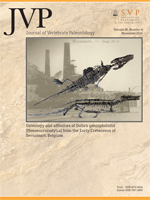Disarticulated remains of palaeobatrachids coming from the early Pleistocene (Gelasian) of Tegelen (The Netherlands) are here described and referred to the new species Palaeobatrachus eurydices. The new species has been included in the first comprehensive phylogenetic analysis considering all known species of the genus Palaeobatrachus and was found to be the sister taxon of the Oligocene/Miocene P. robustus. Palaeobatrachus eurydices P. robustus form a clade with P. langhae, and this latter clade is sister to all other Palaeobatrachus species. Extreme adaptation to permanent life in water is evidenced in P. eurydices by absence of the fossa cubitalis ventralis, and less developed olecranon on the radioulna. The water-rich and warm environment of Tegelen, indicated by other elements of the fauna such as beavers and the terrapin Mauremys, could have acted as a refugium for these water-dwelling anurans, which were thought to have disappeared from western Europe by the Miocene/Pliocene boundary.
How to translate text using browser tools
1 November 2016
Palaeobatrachus eurydices, sp. nov. (Amphibia, Anura), the Last Western European Palaeobatrachid
Andrea Villa,
Zbyněk Roček,
Emanuel Tschopp,
Lars W. Van Den Hoek Ostende,
Massimo Delfino
ACCESS THE FULL ARTICLE





